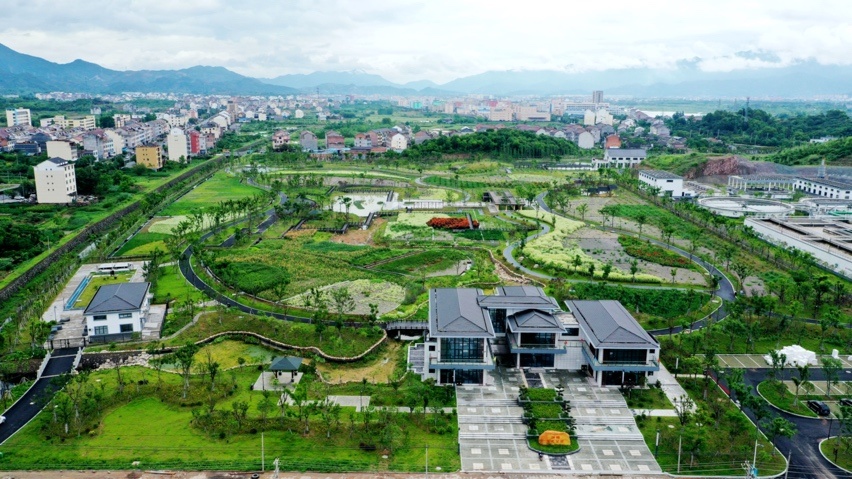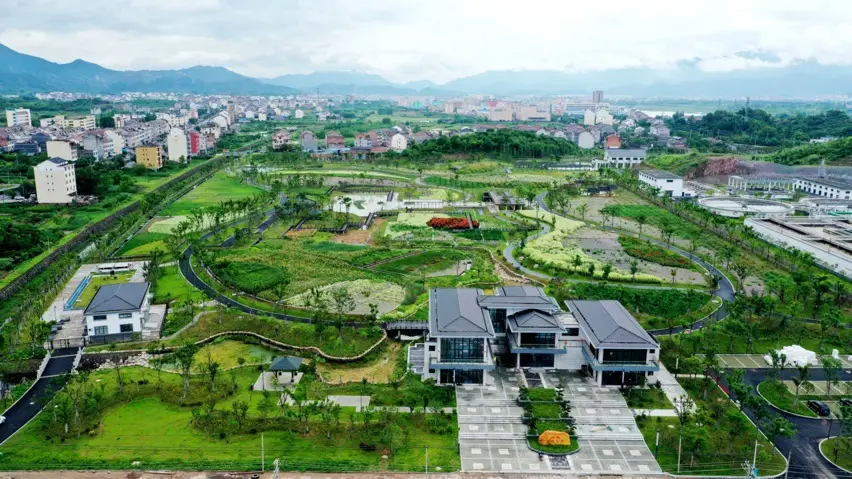By Shen Shen, People’s Daily

A bird’s eye view of the wetland park in a sewage treatment plant in Xianju county, Taizhou, East China’s Zhejiang Province on June 6. (Photo by Wang Huabin/People’s Daily Online)
New progress has been recently achieved in measuring the gross ecosystem product (GEP) by a research team of Research Center for Eco-Environmental Sciences, Chinese Academy of Sciences (CAS).
Based on their empirical research in Northwest China’s Qinghai Province, researchers provided the world with a scientific approach to quantifying nature’s contribution to human beings.
The research result indicated that the correlation between the suppliers and beneficiaries of the products and services in the ecosystem can be revealed in a quantitative way by the GEP.
In addition, the GEP can also serve as a scientific basis for evaluating ecological protection results and decision-making of eco-compensation policies, thus helping incorporate ecological benefits into the evaluation system of economic and social development.
In an effort to assess the value of ecological environment and measure the effect of ecological and environmental protection efforts, the International Union for Conservation of Nature (IUCN) and the Research Center for Eco-Environmental Sciences of CAS put forward the calculation system for the GEP.
The calculation system contains a set of statistical methods corresponding to that of the gross domestic product (GDP), which can help measure the quality of ecological environment.
By calculating the total output value of natural ecosystems like forest, desert, and wetland, as well as artificial ecosystems such as farmland and pasture, the calculation system for the GEP can be used to evaluate and demonstrate the condition of ecosystems.
The GEP is the total value of the final ecosystem products and services supplied to human well-being and the sustainable economic and social development, as defined by researchers.
There are a series of relatively mature evaluation systems for measuring economic and social development, such as the GDP, which has been used to measure the monetary value of all the final goods and services produced in a country or a region during a specific period, and the Human Development Index (HDI) that measures average life expectancy, degree of education, and standard of living.
As the first of its kind in the world, the proposal of the GEP represents an attempt to fill the gap in calculating indicators of the support ecosystems provides for human well-being and development.
Since December 30, 2018, Shenzhen, South China’s Guangdong Province has introduced the country’s first local standards for the calculating of the GEP, breaking the conventional stereotype of regarding the GDP as the only criterion for evaluating economic development.
Many cities have since cast their eyes on the GEP, thus gaining rich fruits of greener development patterns and higher quality of economic development.
In recent years, China has attached greater importance to the construction of ecological civilization.
From making great efforts for pollution treatment to carrying out strict supervision over environmental protection work, and from piloting the system of compensation for ecological and environmental damage, to adding ecological and environmental protection to government performance evaluation system, China has witnessed continuous improvement in its quality of ecological environment.
The calculating of the GEP is a significant move with a far-reaching influence. By establishing the GEP-related macro indicators, relevant authorities can not only quantify the achievements in ecological civilization construction, but also use these quantitative indicators to better evaluate the work of government officials.
Meanwhile, these indicators can also serve as the quantitative basis of the results of endeavors to promote ecological benefit compensation, nature conservation, and ecological restoration.
While reflecting the modernization level of China’s ecological and environmental governance capability and system, the innovative evaluation criterion also represents a valuable exploration of global ecological governance.
As the calculation system of the GEP matures gradually and gains wider application in ecological environment evaluation and policy-making, the measure will become an increasingly effective positive incentive to help turn the blueprint for a more beautiful China into reality.
Based on their empirical research in Northwest China’s Qinghai Province, researchers provided the world with a scientific approach to quantifying nature’s contribution to human beings.
The research result indicated that the correlation between the suppliers and beneficiaries of the products and services in the ecosystem can be revealed in a quantitative way by the GEP.
In addition, the GEP can also serve as a scientific basis for evaluating ecological protection results and decision-making of eco-compensation policies, thus helping incorporate ecological benefits into the evaluation system of economic and social development.
In an effort to assess the value of ecological environment and measure the effect of ecological and environmental protection efforts, the International Union for Conservation of Nature (IUCN) and the Research Center for Eco-Environmental Sciences of CAS put forward the calculation system for the GEP.
The calculation system contains a set of statistical methods corresponding to that of the gross domestic product (GDP), which can help measure the quality of ecological environment.
By calculating the total output value of natural ecosystems like forest, desert, and wetland, as well as artificial ecosystems such as farmland and pasture, the calculation system for the GEP can be used to evaluate and demonstrate the condition of ecosystems.
The GEP is the total value of the final ecosystem products and services supplied to human well-being and the sustainable economic and social development, as defined by researchers.
There are a series of relatively mature evaluation systems for measuring economic and social development, such as the GDP, which has been used to measure the monetary value of all the final goods and services produced in a country or a region during a specific period, and the Human Development Index (HDI) that measures average life expectancy, degree of education, and standard of living.
As the first of its kind in the world, the proposal of the GEP represents an attempt to fill the gap in calculating indicators of the support ecosystems provides for human well-being and development.
Since December 30, 2018, Shenzhen, South China’s Guangdong Province has introduced the country’s first local standards for the calculating of the GEP, breaking the conventional stereotype of regarding the GDP as the only criterion for evaluating economic development.
Many cities have since cast their eyes on the GEP, thus gaining rich fruits of greener development patterns and higher quality of economic development.
In recent years, China has attached greater importance to the construction of ecological civilization.
From making great efforts for pollution treatment to carrying out strict supervision over environmental protection work, and from piloting the system of compensation for ecological and environmental damage, to adding ecological and environmental protection to government performance evaluation system, China has witnessed continuous improvement in its quality of ecological environment.
The calculating of the GEP is a significant move with a far-reaching influence. By establishing the GEP-related macro indicators, relevant authorities can not only quantify the achievements in ecological civilization construction, but also use these quantitative indicators to better evaluate the work of government officials.
Meanwhile, these indicators can also serve as the quantitative basis of the results of endeavors to promote ecological benefit compensation, nature conservation, and ecological restoration.
While reflecting the modernization level of China’s ecological and environmental governance capability and system, the innovative evaluation criterion also represents a valuable exploration of global ecological governance.
As the calculation system of the GEP matures gradually and gains wider application in ecological environment evaluation and policy-making, the measure will become an increasingly effective positive incentive to help turn the blueprint for a more beautiful China into reality.
 Menu
Menu
 Methods for measuring gross ecosystem product help China better improve ecological civilization
Methods for measuring gross ecosystem product help China better improve ecological civilization
















